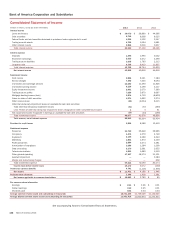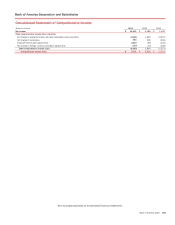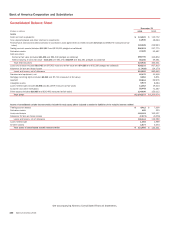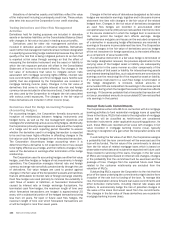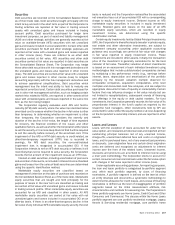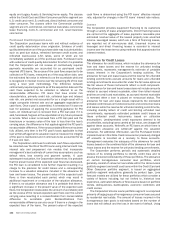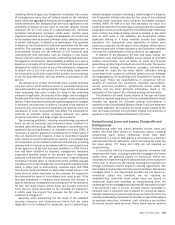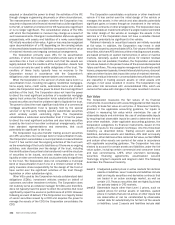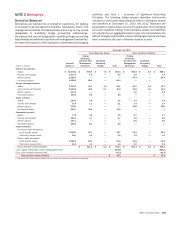Bank of America 2013 Annual Report Download - page 157
Download and view the complete annual report
Please find page 157 of the 2013 Bank of America annual report below. You can navigate through the pages in the report by either clicking on the pages listed below, or by using the keyword search tool below to find specific information within the annual report.Bank of America 2013 155
in the fair value of securities financing agreements that are
accounted for under the fair value option are recorded in trading
account profits in the Consolidated Statement of Income. For more
information on securities financing agreements that the
Corporation accounts for under the fair value option, see Note 21
– Fair Value Option.
The Corporation’s policy is to obtain possession of collateral
with a market value equal to or in excess of the principal amount
loaned under resale agreements. To ensure that the market value
of the underlying collateral remains sufficient, collateral is
generally valued daily and the Corporation may require
counterparties to deposit additional collateral or may return
collateral pledged when appropriate. Securities financing
agreements give rise to negligible credit risk as a result of these
collateral provisions and, accordingly, no allowance for loan losses
is considered necessary.
Substantially all repurchase and resale activities are
transacted under legally enforceable master repurchase
agreements that give the Corporation, in the event of default by
the counterparty, the right to liquidate securities held and to offset
receivables and payables with the same counterparty. The
Corporation offsets repurchase and resale transactions with the
same counterparty on the Consolidated Balance Sheet where it
has such a legally enforceable master netting agreement and the
transactions have the same maturity date.
In transactions where the Corporation acts as the lender in a
securities lending agreement and receives securities that can be
pledged or sold as collateral, it recognizes an asset on the
Consolidated Balance Sheet at fair value, representing the
securities received, and a liability for the same amount,
representing the obligation to return those securities.
In repurchase transactions, typically, the termination date for
a repurchase agreement is before the maturity date of the
underlying security. However, in certain situations, the Corporation
may enter into repurchase agreements where the termination date
of the repurchase transaction is the same as the maturity date of
the underlying security and these transactions are referred to as
“repo-to-maturity” (RTM) transactions. In accordance with
applicable accounting guidance, the Corporation accounts for RTM
transactions as sales and purchases when the transferred
securities are highly liquid. In instances where securities are
considered sold or purchased, the Corporation removes the
securities from or recognizes the securities on the Consolidated
Balance Sheet and, in the case of sales, recognizes a gain or loss,
where applicable, in the Consolidated Statement of Income. At
December 31, 2013 and 2012, the Corporation had no
outstanding RTM transactions that had been accounted for as
sales and an immaterial amount of transactions that had been
accounted for as purchases.
Collateral
The Corporation accepts securities as collateral that it is permitted
by contract or custom to sell or repledge. At December 31, 2013
and 2012, the fair value of this collateral was $575.3 billion and
$513.2 billion, of which $361.5 billion and $362.0 billion was
sold or repledged. The primary source of this collateral is securities
borrowed or purchased under agreements to resell. The
Corporation also pledges company-owned securities and loans as
collateral in transactions that include repurchase agreements,
securities loaned, public and trust deposits, U.S. Treasury tax and
loan notes, and short-term borrowings. This collateral, which in
some cases can be sold or repledged by the counterparties to the
transactions, is parenthetically disclosed on the Consolidated
Balance Sheet.
In certain cases, the Corporation has transferred assets to
consolidated VIEs where those restricted assets serve as
collateral for the interests issued by the VIEs. These assets are
included on the Consolidated Balance Sheet in Assets of
Consolidated VIEs.
In addition, the Corporation obtains collateral in connection
with its derivative contracts. Required collateral levels vary
depending on the credit risk rating and the type of counterparty.
Generally, the Corporation accepts collateral in the form of cash,
U.S. Treasury securities and other marketable securities. Based
on provisions contained in master netting agreements, the
Corporation nets cash collateral received against derivative
assets. The Corporation also pledges collateral on its own
derivative positions which can be applied against derivative
liabilities.
Trading Instruments
Financial instruments utilized in trading activities are carried at
fair value. Fair value is generally based on quoted market prices
or quoted market prices for similar assets and liabilities. If these
market prices are not available, fair values are estimated based
on dealer quotes, pricing models, discounted cash flow
methodologies, or similar techniques where the determination of
fair value may require significant management judgment or
estimation. Realized and unrealized gains and losses are
recognized in trading account profits.
Derivatives and Hedging Activities
Derivatives are entered into on behalf of customers, for trading or
to support risk management activities. Derivatives used in risk
management activities include derivatives that are both
designated in qualifying accounting hedge relationships and
derivatives used to hedge market risks in relationships that are
not designated in qualifying accounting hedge relationships
(referred to as other risk management activities). Derivatives
utilized by the Corporation include swaps, financial futures and
forward settlement contracts, and option contracts. A swap
agreement is a contract between two parties to exchange cash
flows based on specified underlying notional amounts, assets
and/or indices. Financial futures and forward settlement contracts
are agreements to buy or sell a quantity of a financial instrument
(including another derivative financial instrument), index, currency
or commodity at a predetermined rate or price during a period or
at a date in the future. Option agreements can be transacted on
organized exchanges or directly between parties.
All derivatives are recorded on the Consolidated Balance Sheet
at fair value, taking into consideration the effects of legally
enforceable master netting agreements that allow the Corporation
to settle positive and negative positions and offset cash collateral
held with the same counterparty on a net basis. For exchange-
traded contracts, fair value is based on quoted market prices in
active or inactive markets or is derived from observable market-
based pricing parameters, similar to those applied to over-the-
counter (OTC) derivatives. For non-exchange traded contracts, fair
value is based on dealer quotes, pricing models, discounted cash
flow methodologies or similar techniques for which the
determination of fair value may require significant management
judgment or estimation.





